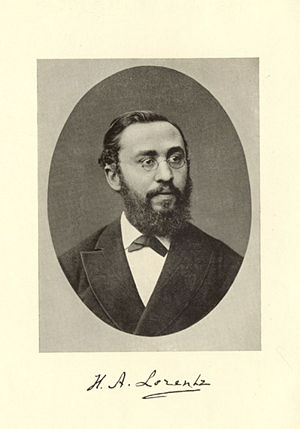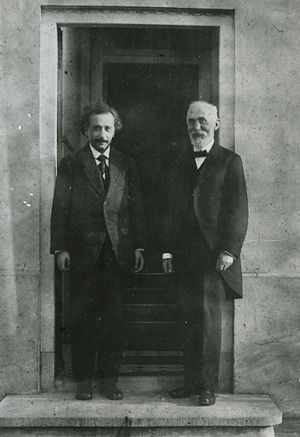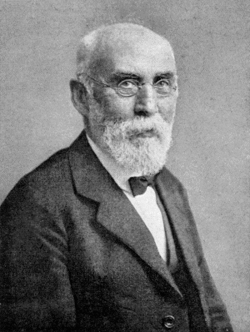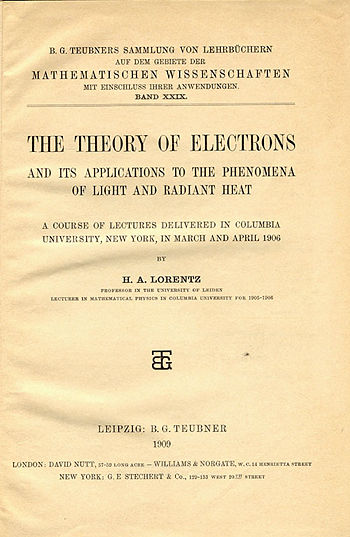Hendrik Antoon Lorentz
Hendrik Antoon Lorentz (Arnhem, July 18, 1853 – Haarlem, February 4, 1928) was one of the greatest Dutch theoretical physicists. He was the second Nobel laureate in physics, together with Pieter Zeeman. They received the prize in 1902 for the discovery (by Zeeman) and the explanation (by Lorentz) of the Zeeman effect, the splitting of spectral lines in a magnetic field.
Lorentz's main contribution to physics was in the theory of electromagnetism in which he continued and extended the work of the Scotsman James Clerk Maxwell.
Biography
Youth
Lorentz was born in the city of Arnhem, the capital of Gelderland, a Dutch province. He was the son of Geertruida van Ginkel and Gerrit Frederik Lorentz, a successful market-gardener, famous for his cauliflowers. When Hentje (as Lorentz was called as a boy) was four years old, he lost his mother. Five years later, in 1862, his father married Luberta Hupkes. Hentje was a quiet, cheerful, and intelligent child with an early interest in mathematics. When he was 10 years old he bought a logarithm table of his pocket money and taught himself how to calculate with it.
In 1866 Lorentz entered the third grade of the newly established high school (HBS, "Hoogere Burger School") in Arnhem. He was an excellent student, not only in the exact sciences, but also in the modern languages, French, English, and German, that, together with the Dutch language, were on the curriculum of the HBS. This type of school did not teach the classical languages, although at that time these were required for admission to the Dutch universities. So, Lorentz took separate lessons in Greek and Latin and after passing the required exams he was admitted to the University of Leiden, in 1869.
Student days
The talents of the young student in physics made a strong impression on his teachers, among whom the astronomy professor Frederik Kaiser. Later, in 1881, Lorentz would marry professor Kaiser's niece. In 1871, at the very early age of 18, Lorentz passed with summa cum laude the candidaatsexamen (comparable to a bachelor's). This was an oral exam with several examiners, who all were aware of Lorentz's reputation. One of the examiners declared after the examination was over that, although Lorentz's performance was satisfactory, he performed less than he had expected. It turned out that the examiner mistakenly thought that he had sat in at a doctoraal examen, also an oral examination, but three full years after the candidaatsexamen.
After having passed his candidaatsexamen, Lorentz returned to Arnhem in 1872 to teach evening high school classes to students of his own age, while continuing his studies in Leiden. He passed his doctoraal examen in 1873 (two years faster than the average student) and wrote a PhD thesis in a period of two years. On December 11, 1875, Lorentz obtained his doctorate degree under Pieter Rijke on a thesis entitled "Over de theorie der terugkaatsing en breking van het licht" (On the theory of reflection and refraction of light), in which he refined the electromagnetic theory of James Clerk Maxwell. This thesis also gained the predicate summa cum laude.
Professorship
In 1878, only 24 years of age, Lorentz was appointed to the newly established chair in theoretical physics at the University of Leiden, the oldest university in the Netherlands. On 25 January 1878, he delivered his inaugural lecture entitled De moleculaire theoriën[1] in de natuurkunde (The molecular theories in physics).
In 1881 Hendrik Lorentz married Aletta Catharina Kaiser (1858-1931), the daughter of Johann Wilhelm Kaiser, director of the Amsterdam's Engraving School and professor of Fine Arts at the Rijksakademie voor Beeldende Kunsten, and designer of the first Dutch postage stamp (1852). The couple had two daughters, Geertruida Luberta (1885), Johanna Wilhelmina (1889), and a son Rudolf (1895). (One son died in infancy). The eldest daughter was to become a physicist as well and later married Wander Johannes de Haas, an experimental physicist of some renown, successor in Leiden of Heike Kamerling-Onnes.
During his years in Leiden, Lorentz was primarily interested in the theory of electromagnetism—the theory of electricity, magnetism, and light. Lorentz theorized already in his thesis that molecules contain charged particles and suggested that the oscillations of these are the source of light. After the experimental discovery of the electron by J. J. Thomson in 1897, the charged particles proved to be electrons. When colleague and former student of Lorentz Pieter Zeeman discovered the Zeeman effect in 1896, Lorentz supplied its theoretical interpretation. The experimental and theoretical work was honored with the Nobel prize in physics in 1902.
Years of fame
Lorentz did not go to conferences abroad at all during the first twenty years of his career. His first conference outside the Netherlands was in 1897 when he received an invitation to give a talk in Düsseldorf, a German city about 65 miles (105 km) from Arnhem, Lorentz's town of birth. However, this would soon change, after 1900 Lorentz became one of the most prominent theoreticians of Europe and did not only receive many invitations for lectures, but also became a much sought-after chairman of international conferences. He had eminent chairman qualities, he spoke French, German, and English fluently and was able to switch instantly between languages. He had a very quick mind and a large knowledge of physics, so that he generally understood the lectures delivered at the conferences that he was chairing, and moreover he was tactful and courteous. In the capacity of chairman he did not limit himself to organizational matters, or to presiding at the meetings, but contributed vitally in preparing the scientific program, choosing the speakers, and summarizing the results. The highlights were the Solvay Councils (Conseils de Physique), the first of which was held in 1911. These conferences were sponsored by the Belgian industrialist Ernest Solvay. Lorentz presided at all five conferences until 1927, the year before his death. In 1906 Lorentz traveled to the U.S. to deliver guest lectures at Columbia University.
Later life
In 1912, Lorentz retired from his professorship in Leiden, and was appointed curator of the physics cabinet of Teyler's Museum and secretary of the Hollandsche Maatschappij der Wetenschappen (Holland Society of the Sciences) in Haarlem. He now became professor extraordinarius at Leiden. In Haarlem he gave popular lectures on science, emulating the Royal Institution of London, and at Leiden he gave a seminar for advanced physics students and colleagues every Monday morning in which he discussed new findings in physics.
Lorentz had a very good relationship with Albert Einstein, who visited Leiden as often as he could. As late as 1953 Einstein wrote about Lorentz: Er war mir persönlich mehr als alle andern, die mir auf dem Lebenswege begegnet sind. [For me personally he was more than all others I have met on my path of life].[2]
World War I
At the beginning of World War I more than 3100 German university professors, Einstein and a few others excepted, undersigned a nationalistic declaration (dated October 23, 1914) that was inspired by an appeal undersigned by 93 prominent German intellectuals. In the latter Aufruf an die Kulturwelt! (Appeal to the Civilized World! October 4, 1914) it was emphasized that the war was a battle against German culture. Further, the Aufruf fiercely denied that German armies had committed war crimes against the Belgian population. This "manifesto of the 93" caused feelings of hatred among the academics in Germany's enemy countries. Lorentz's country, the Netherlands, had been neutral during WW I, and Lorentz had corresponded with colleagues on both sides of the front. After the war he worked hard to achieve reconciliation and to convince his colleagues in the former Allied countries to admit German and Austrian scientists to the international community again, but he was not very successful. For instance, he was not allowed to invite any German physicists for the 1921 Solvay conference in Brussels (the capital of Belgium, a country that had suffered immensely). In 1923 Lorentz became a member of Commission Internationale de Coopération Intellectuelle, a committee of the League of Nations. In 1925 he succeeded Henri Bergson as chairman of this committee.
Zuiderzee committee
In the days of Lorentz, the Netherlands contained a large bay in open connection to the North Sea, called the Zuiderzee. This salt water bay regularly flooded the surrounding areas, so that a plan arose to build a huge dam (the Afsluitdijk) closing off the Zuiderzee from the North Sea. Of course, this dam would greatly affect currents and tides; to predict possible changes a committee was formed with Lorentz in the chair. Lorentz proposed to start from the basic hydrodynamic equations of motion and solve the problem numerically. From 1918 to 1926 he derived almost single-handedly the necessary hydrodynamic equations for the effects of the dam on the sea currents and finally he advised the government to go ahead and to build it. The dam was finished in 1932, four years after Lorentz's death and Lorentz's predictions turned out to be correct. At present the former Zuiderzee is a fresh water lake (called the IJsselmeer) and large part of it has been turned into dry land (into three polders).
Death
In 1928, shortly after returning from a visiting professorship at the California Institute of Technology, Hendrik Antoon Lorentz died rather unexpectedly and suddenly of Erysipelas, an acute bacterial infection of the skin. His funeral took place in Haarlem at noon on Friday, February 10. At the stroke of twelve the State telegraph and telephone services of Holland were suspended for three minutes as a tribute to the deceased. The funeral procession, consisting of 15 horse-drawn carriages drew crowds of ten thousands of spectators. Present at the funeral were many famous physicists, among whom Albert Einstein and Sir Ernest Rutherford
Work
Lorentz's work bridges classical (Newtonian and Maxwellian) and modern (relativistic and quantum) physics. Although Lorentz died believing in the existence of the ether, he formulated its properties in such a way that a modern scientist easily recognizes it as the vacuum carrying an electric and/or a magnetic field. Also, Lorentz remained a classical physicist in that he could not accept that the length contraction (now called the Lorentz-FitzGerald contraction) of a rod at a speed approaching the speed of light is a kinematic effect, as was shown by Einstein in 1905. Lorentz remained of the opinion that the high velocity of the rod affected the forces between its molecules, i.e., that length contraction has a dynamic, not a kinematic, origin. Lorentz published his contraction formula in a communication to the Dutch Academy (1892) as an attempt to explain the null result of the Michelson-Morley experiment. FitzGerald never published his formula, but Oliver Lodge mentioned it in a Nature article[3] a few months before Lorentz's communication.
Lorentz paved the way for Einstein's special theory of relativity of 1905 by formulating transformations,[4] now known as Lorentz transformations, that are central to Einstein's theory. Lorentz added to the usual three space coordinates a fourth one— that he called local time—and showed that the Maxwell equations are covariant (keep their form) under a Lorentz transformation of the four coordinates. He thus came very close to introducing Einstein's famous "fourth dimension" of the space-time continuum. In fact, he came so close to introducing the special theory of relativity that E. T. Whittaker[5] attributed relativity theory to Lorentz and the French mathematician Poincaré, belittling the significance of Einstein's contribution. It is generally held that Whittaker was mistaken, see for instance the criticism by Pais.[6] Poincaré, who in 1906 had published a long paper bearing on relativity, called Lorentz one of the grands démolisseurs (great demolishers) of Newtonian mechanics.
Through the 1880s Lorentz was mainly concerned with molecular physics, chiefly in the context of the mechanical theory of heat. Lorentz returned to electrodynamics, the topic of his 1875 thesis, in the early 1890s. He had convinced himself of two things since the time of his thesis. In 1886, he concluded that Augustin Fresnel's stationary ether was superior to G. G. Stokes' dragged ether. His second conclusion was that action carried by a field and propagating with the speed of light—the core of the Faraday-Maxwell theory—was preferable to action at a distance.
In 1892, Lorentz published his first statement of—what he would call after 1899—the theory of electrons. This work was on the motion of ponderable (material) particles in electric and magnetic fields. The attempts of Maxwell and Hertz to extend the theory of the electromagnetic field to the case of charged bodies in motion with respect to the ether had not been altogether successful. Already in his PhD thesis, Lorentz foresaw the enormously fruitful consequences that the introduction of material molecules into electromagnetic theory could have. Thus, Lorentz assumed that matter consists of molecules and that these carry charged corpuscles, which he called "charged particles" in 1892, "ions" in 1895, and from 1899 onward "electrons". The motion of the electrons was described by a harmonic oscillator model, i.e., he assumed pendular motions for the charges in the molecules. He introduced the concept of polarization of matter, which he took to be the sum of the molecular polarizations. By means of this concept he was able to write down modified Maxwell equations, which are now known as the macroscopic Maxwell equations (valid in the presence of continuous polarizable matter). In addition, Lorentz derived by a Lagrangian formalism the force ("elektrische Kraft") acting on a charge moving through an electric and a magnetic field, a force which is now called the Lorentz force. Although independently both Maxwell and Oliver Heaviside had given earlier the same expression for this force, their expression had escaped the attention of their contemporaries, but when Lorentz published the equation again in the context of his electron theory, physicists were ready for it.
It is, parenthetically, of some interest to note that in his 1892 memoir Lorentz used the same kind of long-hand (component) notation as Maxwell had used twenty years earlier, while in his 1895 booklet Versuch einer Theorie Lorentz employed vector analysis concepts like curl, grad, and div. The 1890s were the years that Willard Gibbs and Oliver Heaviside converted Hamilton's quaternion theory into the vector analysis that is still in use today. Apparently, this development had not gone unnoticed by Lorentz.
In 1896 the young privaatdocent Pieter Zeeman, a former student of Lorentz, investigated the influence of a magnetic field on the yellow spectral D-lines of sodium. Zeeman was inspired by Michael Faraday, who in 1862 had in vain tried to observe such an influence. Because Zeeman now had a stronger magnetic field at his disposal (ca. 1 tesla) and a Rowland grating he could do much better than Faraday 34 years earlier. Zeeman saw a line broadening in sodium and a year later he saw a splitting (now called the Zeeman splitting) in the blue line of cadmium. Zeeman's observation was soon explained by Lorentz who considered an electron bound by harmonic forces to the sodium atom and subject to a Lorentz force. Lorentz showed that there are two vibrations perpendicular to the direction of the magnetic field with slightly different energies, the energy difference being proportional to , the ratio of charge and mass of the electron. Using Lorentz's formula Zeeman gave the first estimate of this important ratio, which was not far from the correct result. Lorentz and Zeeman shared the 1902 Nobel Prize for this work.
The striking novelty of relativistic physics and quantum theory, both following closely upon Lorentz's electron theory, have tended to obscure the contemporary reputation of Lorentz's work. Toward the end of his life Einstein wrote that physics had absorbed so much of Lorentz's achievement that its unexpected, audacious character had been largely forgotten.[2]
Notes and references
- ↑ In modern Dutch: theorieën
- ↑ Jump up to: 2.0 2.1 A. Einstein (1953). H. A. Lorentz als Schöpfer und Persönlichkeit. In: de Clercq, Peter, and van Helden, Anne C. (eds.). Albert Einstein & Museum Boerhave. Leiden: Museum Boerhave, 1993. Includes a facsimile reproduction, a transcription, and Dutch and English translations of the document. See also H.A. Lorentz; His Creative Genius and His Personality Mededeling no. 91 from the Rijksmuseum voor de Geschiedenis de Natuurwetenschappen, Leiden (1953)
- ↑ O. Lodge,On the present state of our knowledge of the connection between ether and matter: an historical summary, Nature vol. 46, pp. 164-165 (16 June 1892)
- ↑ H. A. Lorentz, Electromagnetic phenomena in a system moving with any velocity smaller than that of light, in: KNAW, Proceedings, 6, pp. 809-831 (1904)
- ↑ E. T. Whittaker, History of the Theories of Aether and Electricity, vol. 2, Nelson and Sons New York (1953)
- ↑ A. Pais, Subtle is the Lord, Oxford University Press, Oxford (1982), p. 168




